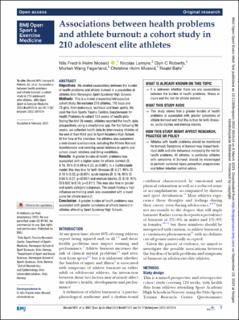| dc.contributor.author | Moseid, Nils Fredrik Holm | |
| dc.contributor.author | Lemyre, Nicolas | |
| dc.contributor.author | Moseid, Christine Holm | |
| dc.contributor.author | Bahr, Roald | |
| dc.contributor.author | Roberts, Glyn C. | |
| dc.contributor.author | Fagerland, Morten Wang | |
| dc.date.accessioned | 2023-10-12T12:48:05Z | |
| dc.date.available | 2023-10-12T12:48:05Z | |
| dc.date.created | 2023-04-27T13:08:51Z | |
| dc.date.issued | 2023 | |
| dc.identifier.citation | BMJ Open Sport & Exercise Medicine. 2023, 9(1), Artikkel e001514. | en_US |
| dc.identifier.issn | 2055-7647 | |
| dc.identifier.uri | https://hdl.handle.net/11250/3096143 | |
| dc.description | This is an open access article distributed in accordance with the Creative Commons Attribution Non Commercial (CC BY-NC 4.0) license, which permits others to distribute, remix, adapt, build upon this work non-commercially, and license their derivative works on different terms, provided the original work is properly cited, appropriate credit is given, any changes made indicated, and the use is non-commercial. | en_US |
| dc.description.abstract | Objectives: We studied associations between the burden of health problems and athlete burnout in a population of athletes from Norwegian Sport Academy High Schools.
Methods: This is a mixed prospective/retrospective cohort study. We included 210 athletes, 135 boys and 75 girls, from endurance, technical and team sports. We used the Oslo Sports Trauma Centres Questionnaire for Health Problems to collect 124 weeks of health data. During the first 26 weeks, athletes reported the health data prospectively using a smartphone app. For the following 98 weeks, we collected health data by interviewing athletes at the end of their third year in Sport Academy High School. At the time of the interview, the athletes also completed a web-based questionnaire, including the Athlete Burnout Questionnaire and covering social relations in sports and school, coach relations and living conditions.
Results: A greater burden of health problems was associated with a higher score for athlete burnout (B: 0.16, 95% CI 0.09 to 0.22, p<0.001). In a multivariable model, this was true for both illnesses (B: 0.21, 95% CI 0.10 to 0.32, p<0.001), acute injuries (B: 0.16, 95% CI 0.04 to 0.27, p=0.007) and overuse injuries (B: 0.10, 95% CI 0.002 to 0.18, p=0.011). This was also true in gender and sports category subgroups. The coach having a high influence on training week was associated with a lower score for athlete burnout.
Conclusion: A greater burden of health problems was associated with greater symptoms of athlete burnout in athletes attending Sport Academy High Schools. | en_US |
| dc.language.iso | eng | en_US |
| dc.subject | adolescent | en_US |
| dc.subject | athlete | en_US |
| dc.subject | illness | en_US |
| dc.subject | injury | en_US |
| dc.subject | mental | en_US |
| dc.title | Associations between health problems and athlete burnout: A cohort study in 210 adolescent elite athletes | en_US |
| dc.type | Peer reviewed | en_US |
| dc.type | Journal article | en_US |
| dc.description.version | publishedVersion | en_US |
| dc.rights.holder | © Author(s) (or their employer(s)) 2023 | en_US |
| dc.source.pagenumber | 11 | en_US |
| dc.source.volume | 9 | en_US |
| dc.source.journal | BMJ Open Sport & Exercise Medicine | en_US |
| dc.source.issue | 1 | en_US |
| dc.identifier.doi | 10.1136/bmjsem-2022-001514 | |
| dc.identifier.cristin | 2143821 | |
| dc.description.localcode | Institutt for idrettsmedisinske fag / Department of Sports Medicine | en_US |
| dc.source.articlenumber | e001514 | en_US |
| cristin.ispublished | true | |
| cristin.fulltext | original | |
| cristin.qualitycode | 1 | |
